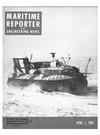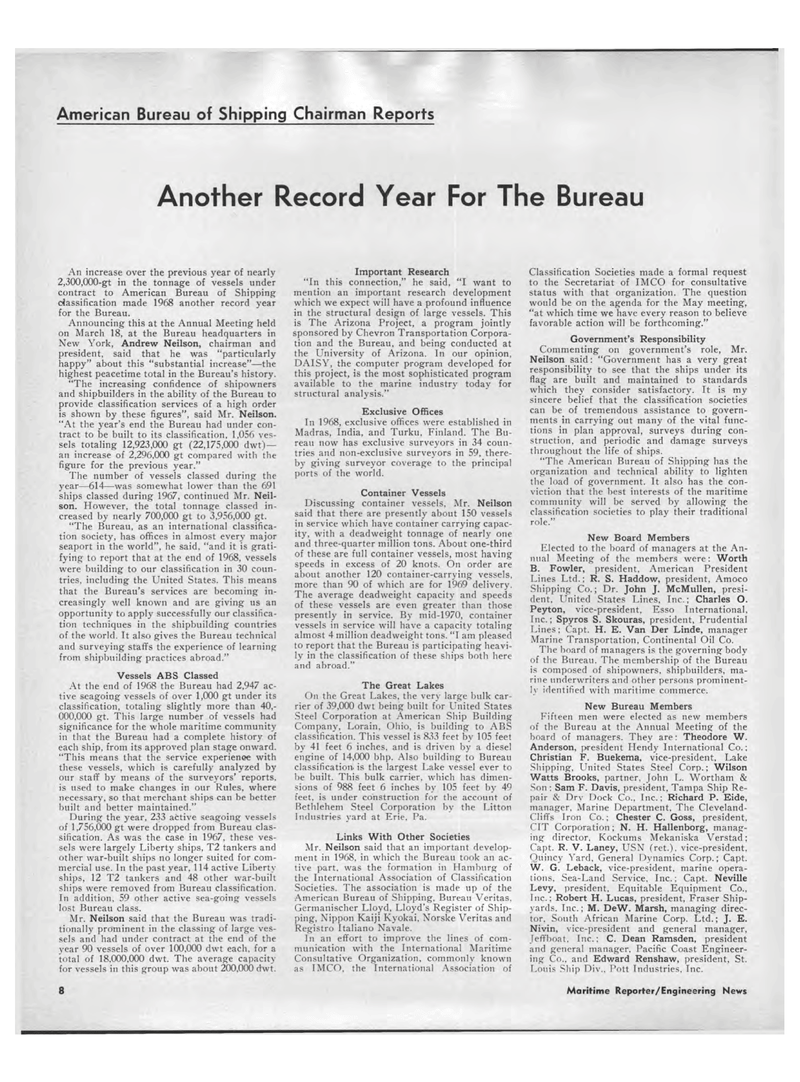
Page 6: of Maritime Reporter Magazine (April 1969)
Read this page in Pdf, Flash or Html5 edition of April 1969 Maritime Reporter Magazine
American Bureau of Shipping Chairman Reports Another Record Year For The Bureau An increase over the previous year of nearly 2,300,000-gt in the tonnage of vessels under contract to American Bureau of Shipping classification made 1968 another record year for the Bureau. Announcing this at the Annual Meeting held on March 18, at the Bureau headquarters in New York, Andrew Neilson, chairman and president, said that he was "particularly happy" about this "substantial increase"?the highest peacetime total in the Bureau's history. "The increasing confidence of shipowners and shipbuilders in the ability of the Bureau to provide classification services of a high order is shown by these figures", said Mr. Neilson. "At the year's end the Bureau had under con-tract to be built to its classification, 1,056 ves-sels totaling 12,923,000 gt (22,175.000 dwt) ? an increase of 2,296.000 gt compared with the figure for the previous year." The number of vessels classed during the year?614?was somewhat lower than the 691 ships classed during 1967, continued Mr. Neil-son. However, the total tonnage classed in-creased by nearly 700,000 gt to 3,956,000 gt. "The Bureau, as an international classifica-tion society, has offices in almost every major seaport in the world", he said, "and it is grati-fying to report that at the end of 1968, vessels were building to our classification in 30 coun-tries, including the United States. This means that the Bureau's services are becoming in-creasingly well known and are giving us an opportunity to apply successfully our classifica-tion techniques in the shipbuilding countries of the world. It also gives the Bureau technical and surveying staffs the experience of learning from shipbuilding practices abroad." Vessels ABS Classed At the end of 1968 the Bureau had 2,947 ac-tive seagoing vessels of over 1,000 gt under its classification, totaling slightly more than 40,-000,000 gt. This large number of vessels had significance for the whole maritime community in that the Bureau had a complete history of each ship, from its approved plan stage onward. "This means that the service experience with these vessels, which is carefully analyzed by our staff by means of the surveyors' reports, is used to make changes in our Rules, where necessary, so that merchant ships can be better built and better maintained." During the year, 233 active seagoing vessels of 1,756,000 gt were dropped from Bureau clas-sification. As was the case in 1967, these ves-sels were largely Liberty ships, T2 tankers and other war-built ships no longer suited for com-mercial use. In the past year, 114 active Liberty-ships, 12 T2 tankers and 48 other war-built ships were removed from Bureau classification. In addition. 59 other active sea-going vessels lost Bureau class. Mr. Neilson said that the Bureau was tradi-tionally prominent in the classing of large ves-sels and had under contract at the end of the year 90 vessels of over 100,000 dwt each, for a total of 18,000,000 dwt. The average capacity for vessels in this group was about 200,000 dwt. Important Research "In this connection," he said, "I want to mention an important research development which we expect will have a profound influence in the structural design of large vessels. This is The Arizona Project, a program jointly sponsored by Chevron Transportation Corpora-tion and the Bureau, and being conducted at the University of Arizona. In our opinion, DAISY, the computer program developed for this project, is the most sophisticated program available to the marine industry today for structural analysis." Exclusive Offices In 1968, exclusive offices were established in Madras, India, and Turku. Finland. The Bu-reau now has exclusive surveyors in 34 coun-tries and non-exclusive surveyors in 59, there-by giving surveyor coverage to the principal ports of the world. Container Vessels Discussing container vessels, Mr. Neilson said that there are presently about 150 vessels in service which have container carrying capac-ity, with a deadweight tonnage of nearly one and three-quarter million tons. About one-third of these are full container vessels, most having speeds in excess of 20 knots. On order are about another 120 container-carrying vessels, more than 90 of which are for 1969 delivery. The average deadweight capacity and speeds of these vessels are even greater than those presently in service. By mid-1970, container vessels in service will have a capacity totaling almost 4 million deadweight tons. "I am pleased to report that the Bureau is participating heavi-ly in the classification of these ships both here and abroad." The Great Lakes On the Great Lakes, the very large bulk car-rier of 39,000 dwt being built for United States Steel Corporation at American Ship Building Company, Lorain, Ohio, is building to ABS classification. This vessel is 833 feet by 105 feet by 41 feet 6 inches, and is driven by a diesel engine of 14,000 bhp. Also building to Bureau classification, is the largest Lake vessel ever to be built. This bulk carrier, which has dimen-sions of 988 feet 6 inches by 105 feet by 49 feet, is under construction for the account of Bethlehem Steel Corporation by the Litton Industries yard at Erie, Pa. Links With Other Societies Mr. Neilson said that an important develop-ment in 1968, in which the Bureau took an ac-tive part, was the formation in Hamburg of the International Association of Classification Societies. The association is made up of the American Bureau of Shipping, Bureau Veritas, Germanischer Lloyd, Lloyd's Register of Ship-ping, Nippon Kaiji Kyokai, Norske Veritas and Registro Italiano Navale. In an effort to improve the lines of com-munication with the International Maritime Consultative Organization, commonly known as IMCO, the International Association of Classification Societies made a formal request to the Secretariat of IMCO for consultative status with that organization. The question would be on the agenda for the May meeting, "at which time we have every reason to believe favorable action will be forthcoming." Government's Responsibility Commenting on government's role, Mr. Neilson said: "Government has a very great responsibility to see that the ships under its flag are built and maintained to standards which they consider satisfactory. It is my sincere belief that the classification societies can be of tremendous assistance to govern-ments in carrying out many of the vital func-tions in plan approval, surveys during con-struction, and periodic and damage surveys throughout the life of ships. "The American Bureau of Shipping has the organization and technical ability to lighten the load of government. It also has the con-viction that the best interests of the maritime community will be served by allowing the classification societies to play their traditional role." New Board Members Elected to the board of managers at the An-nual Meeting of the members were: Worth B. Fowler, president, American President Lines Ltd.; R. S. Haddow, president, Amoco Shipping Co.; Dr. John J. McMullen, presi-dent, United States Lines, Inc.; Charles O. Peyton, vice-president, Esso International, Inc.; Spyros S. Skouras, president, Prudential Lines; Capt. H. E. Van Der Linde, manager Marine Transportation, Continental Oil Co. The board of managers is the governing body of the Bureau. The membership of the Bureau is composed of shipowners, shipbuilders, ma-rine underwriters and other persons prominent-ly identified with maritime commerce. New Bureau Members Fifteen men were elected as new members of the Bureau at the Annual Meeting of the board of managers. They are: Theodore W. Anderson, president Hendy International Co.; Christian F. Buekema, vice-president, Lake Shipping, United States Steel Corp.; Wilson Watts Brooks, partner. John L. Wortham & Son : Sam F. Davis, president, Tampa Ship Re-pair & Drv Dock Co., Inc.; Richard P. Eide, manager. Marine Department, The Cleveland-Cliffs Iron Co.; Chester C. Goss, president, CIT Corporation ; N. H. Hallenborg, manag-ing director. Kockums Mekaniska Verstad; Capt. R. V. Laney, USN (ret.), vice-president, Quincy Yard, General Dynamics Corp.; Capt. W. G. Leback, vice-president, marine opera-tions. Sea-Land Service, Inc.; Capt. Neville Levy, president, Equitable Equipment Co., Inc.; Robert H. Lucas, president, Eraser Ship-yards. Inc.; M. DeW. Marsh, managing direc-tor, South African Marine Corp. Ltd.; J. E. Nivin, vice-president and general manager, Jeffboat, Inc.; C. Dean Ramsden, president and general manager. Pacific Coast Engineer-ing Co., and Edward Renshaw, president, St. Louis Ship Div., Pott Industries, Inc. 8 Maritime Reporter/Engineering News

 5
5

 7
7
